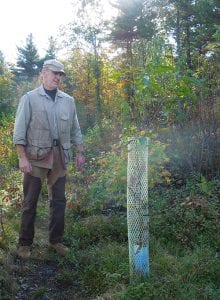
Small chestnut seedling protected by a tree tube.
In 2015 the Leominster Sportsmen’s Assoc., Inc. (LSA) in Leominster, MA had four forest management/wildlife habitat improvement clearcuts conducted totaling 20+ acres. Three of the clearcuts are near the top of a hill-ridge system and the other is on the eastern slope. This is very rough terrain. Over a three year period, Jamie Donalds of the MA/RI-TACF Chapter provided me with a total of 210 nuts which were planted on the clearcuts as follows: 50 nuts in 2015, 100 nuts in 2016, and 60 in 2017. I staked in all rodent protection tubes, and later all the bio-photodegradable deer protection mesh tubes.
All of these nuts required hand watering given their distance from water sources. This was not an easy job. Water was transported to the planting sites in five-gallon lidded paint buckets by my Subaru Outback over a bumpy dirt road. The water was then transferred to garden-variety watering cans carried out to each planting. The nuts were competing with native tree species, including native chestnut sprouts and grasses, sedges, briars, laurel, low-bush blueberries, etc.
Despite the 2015 and 2016 summer drought conditions 140 chestnuts are now growing on the four clearcuts which are becoming thick with secondary growth. Unfortunately, during the extreme July and August 2016 heat and dryness — the only summer from the outset during which I had volunteers to help with watering — there was a two week gap when, due to vacations and travel, watering could not be accomplished and some chestnut mortality occurred as a result.

Jim Gettens checks on a seedling growing in a tree tube.
Each spring and fall I clear competing growth from around the chestnut trees using shears and a machete. It’s a lot of work! Regularly, a few of the the bio-photodegradable mesh protective tubes need propping up or replacing because they have been bumped by deer, flattened by moose, or their wooden stakes have rotted out.
The next goal is to label these trees so they remain identifiable as chestnuts not to be cut in the future when I am long gone. Some of these trees grown from nuts are now 12′ tall. A very few are still struggling seedlings and have concluded that they are in poorly drained soil strata, not readily apparent when the nuts were planted.
Chestnut growing in forest settings can be very challenging and equally rewarding. Food for thought: If you’re considering forest plantings be sure to think about the distance from water sources, continuing efforts to clear competing growth, maintaining rodent and deer protection tubes, and volunteer help.
